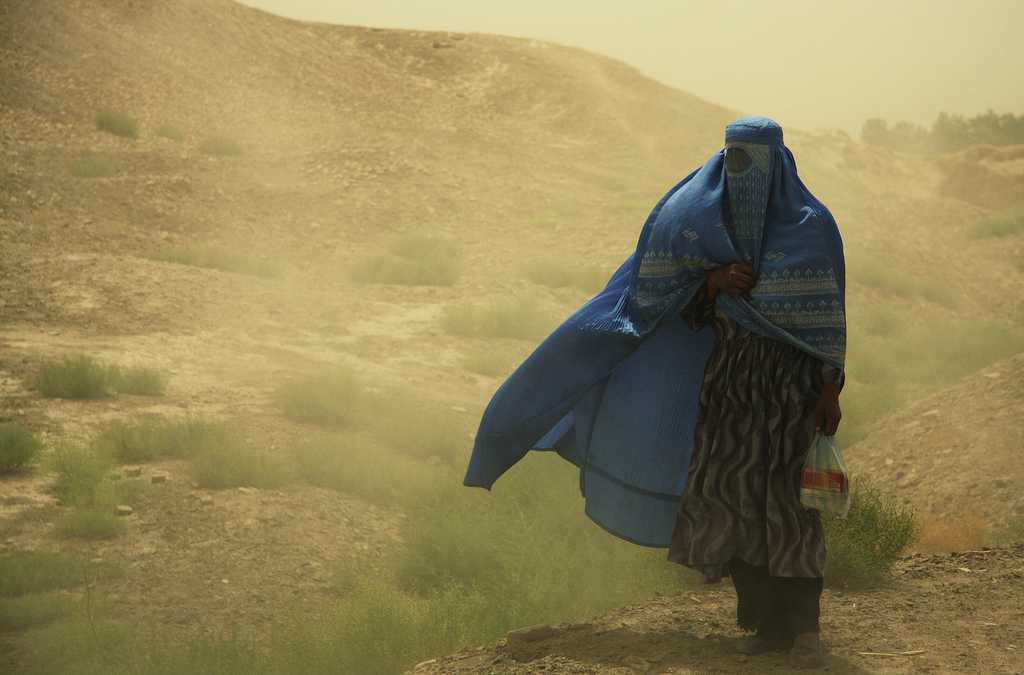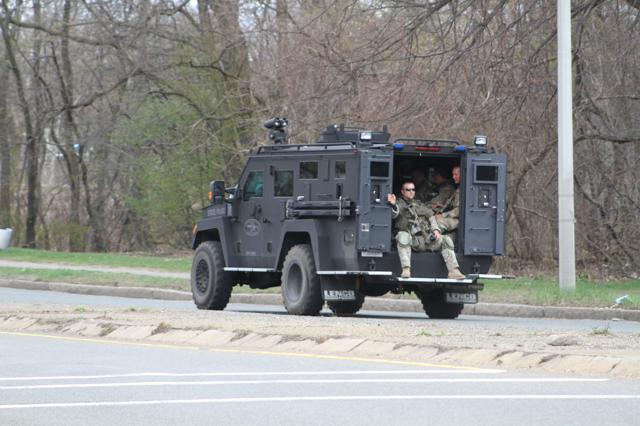On November 17, 2001, Laura Bush made an appeal to the American people to support the war in Afghanistan. In her speech, no link was made between the military operation in Afghanistan and the September 11th attacks. Instead, she called upon the American people to support an operation that would encompass the salvation of Afghan women, “to kick off a world-wide effort to focus on the brutality against women and children by the al-Qaeda terrorist network and the regime it supports in Afghanistan, the Taliban.”[i] Called “women of cover,” by former president George W. Bush, Muslim women are rendered static victims in a discourse of transnational feminism that has been deployed to justify military intervention in the Middle East and Afghanistan.
Today Western media actively produces a picture of Muslim women as passive victims of their circumstance in need of saving. When we dig beyond the learned narrative of the Muslim woman, and cast away learned tropes, we find agential characters who value their societies and religion. The real narrative of the Muslim woman is more nuanced and self-determined than we are led to believe. Three centuries of deliberate Western discourse on these women obfuscates this reality from the gaze of the Western eye. A look ‘beyond the veil’ shows just how culturally, economically and politically destructive the false narrative of the Muslim woman has been.

An appeal to support a war to save a foreign country’s ‘women and children’ is by no means a new rallying call. Leila Ahmed, an influential Egyptian feminist wrote the classic 1992 text Women and Gender in Islam, in which she dubs the term, “colonial feminism.” In discourses of colonial feminism, imperial Britain showed a serious concern for Muslim women rhetorically, mobilizing the veil as a symbol of their oppression. This discourse made the colonial interventions more palatable and valid to those at home. Though employing the rhetoric of salvation, British occupiers did little to support women’s education or development in the colonies and were insistently against women’s suffrage at home.[ii]
Resonating with similar themes to the narratives that validated colonialism, the Afghan woman has become a cause célèbre in the United States in the last decade. Even though the Taliban imposed harsh and abusive restrictions on women as early as 1994, it was not until a media trend showcasing Afghan women wearing the burqa, a Taliban-mandated garment that covered them from head to toe, that public outrage ensued.[iii] The Islamic practice of veiling has functioned as the main symbol of women’s oppression in Western narratives. The veil has been cast once again as a specter of oppression, a device that “the terrorists would like to impose on us,” as Laura Bush put it in her 2001 address to the nation.[iv] The fact that women in pre-Taliban Afghanistan willingly wore the burqa as a culturally relevant sign of their modesty and self-worth is way-sided in the discourse.
This is not to say that there is no room for humanitarian discourse or action in internationalism. Remembering scholar Roland Barthes’ argument for “progressive humanism,” humanitarian discourse must shift to a framework that “not only acknowledges human suffering but also narrative authority, historical agency, and political memory,” in order to espouse truly progressive discourse.[v] That discourse is void in mass media’s rendering of the Muslim woman. The symptom of engaging with the historic discourse of the victimized Muslim woman is not just a misguided public. This discourse has heavily obfuscated pertinent political realities from the eye of the public, and has side tracked a necessary global discourse on the real problems and threats facing women in Afghanistan and beyond.
In a cornerstone text on the production of the Muslim woman in Western media entitled, Do Muslim Women Really Need Saving? Lila Abu-Lughod addresses the ethics of launching a war in the name of salvation. She insists “the tendencies to plaster neat cultural icons like the Muslim woman over messy historical and political dynamics” perpetuate global problems and misunderstandings as it blurs political realities with a guise of Western superiority and a “necessitated” use of violence.[vi] The positioning of women in the forefront of the discourse on Afghanistan renders the historic and political context of the country illegible, including the reality that the rise of the Taliban in Afghanistan was due in part to the Soviet and American intervention in the region during the Cold War.
Abu-Lughod does not advocate for the passivity implied by some cultural relativist discourses, but argues that cultural relativism is a more constructive alternative to ethnocentrism. She asks that we not only look toward the salvation of women in Afghanistan from the Taliban, but salvation too from a global imperialist order that perpetuates inequity and economic domination. She calls too for a simultaneous reevaluation of thought, in which we open our scope of discourse to allow for the idea that women in other parts of the world may have different desires or conceptions of social justice than our own. For instance, she notes, once Afghan women were “liberated” from the Taliban, they did not cast off their veil.[vii]
Saba Mahmood, a professor at the University of Chicago, uncovers the magnitude of devastation wrought in Afghanistan due to the US-Soviet proxy war in the 1980s and the present US operation. Discourse on this reality, she states, is illegitimately neutralized and set-aside by the discourse of salvation. Mahmood cites several feminist campaigns in the US that work to advocate for the emancipation of suffering Afghan women. These campaigns, however, do not contain discourses linking the present plight of Afghan women to US Cold War-era support for Afghan religious militias in the 1980s.[viii]
Funding went to Afghanistan during the Cold War to assist Afghanistan in combating Soviet militias, a mission that the US and Saudi Arabia tasked as essential to combating Communism. During the campaign, an estimated 75% of US aid was funneled to extreme religious militias, thus marginalizing secular forces in the country. Gulbuddin Hekmatyar, whose group received as much as 50% of American aid, was known for throwing acid on the faces of women who refused to veil. When questioned on the matter, a US agent in Pakistan retorted, “Fanatics fight better.” Furthermore, a leak in arms delivery between the US and the Afghani Mujahedeen went unchecked as “a necessary cost of a covert operation,” thus allowing small arms to be sold in markets and arming radical groups who exercised violence on non-combatants.[ix] Some Afghans and Taliban leaders have posited questions about why the West was not more concerned about the plight of women then.[x]
Because of the mainstream humanitarian discourse, many in the West are lead to believe that the plight of women in Afghanistan is entirely due to the policy of the Taliban.[xi] Today, the reality is blurred. Afghanistan, a country already suffering from bouts of severe drought, has a compounded food crisis because US bombing made food delivery too treacherous. Discourse fades on the mounting civilian casualties of the war or the legacy of a reckless distribution of small arms.[xii] The crusade to save Afghanistan’s women overshadowed the ills of historic American military might in the country. The discourse of salvation has blurred reprehensible political realities from the world’s vision. It distracts the global citizen from the idea that the plight of Afghan women has largely been an effect of decades of militarization, armament, intervention, and ethnic violence, much of which took place at the hands of the United States.
A closer look at Muslim women shows a heterogeneous body of women who act and advocate for themselves based on their own ideals and values. It reveals a body of women who need to be released from their role as pawns of the West more than they need a crusade for salvation. As protests and a call for emancipation sweep the Arab world this year, the voices of Muslim women have broken through the barrier of false narratives and have shown the force and dynamism of the Muslim woman. A departure from these stereotypes is essential to a discourse that will truly liberate not only Muslim women but also all people who are victims of historically entrenched global inequity today.
[i] US Government, “September 11, 2001: Attack on America” Radio Address by Laura Bush to the Nation, November 17, 2001.
[ii] Leila Ahmed, “Women and Gender in Islam: Historical Roots of a Modern Debate,” Yale University Press: New Haven, 1992.
[iii] Megan Reif, “Beyond the Veil, Bigger Issues,” Christian Science Monitor, May 3, 2000. http://www.csmonitor.com/durable/2000/05/03/fp11s1-csm.shtml
[iv] U.S. Government, 2001
[v] Lisa Malkki, “Speechless Emissaries: Refugees, Humanitarianism, and Dehistoricization,” Cultural Anthropology, 11(3):377-404, 1996.
[vi] Lila Abu-Lughod, “Do Muslim Women Really Need Saving?” American Anthropologist, 104(3): 783-790, 2002.
[vii] Lila Abu-Lughod, 2002
[viii] Saba Mahmood, “Feminism, the Taliban, and Politics of Counter-Insurgency,” Anthropological Quarterly, Volume 75, Number 2, Spring 2002, pp. 339-354.
[ix] Mahmood, 2002
[x] Reif, 2000
[xi] Mahmood, 2002
[xii] Mahmood, 2002



